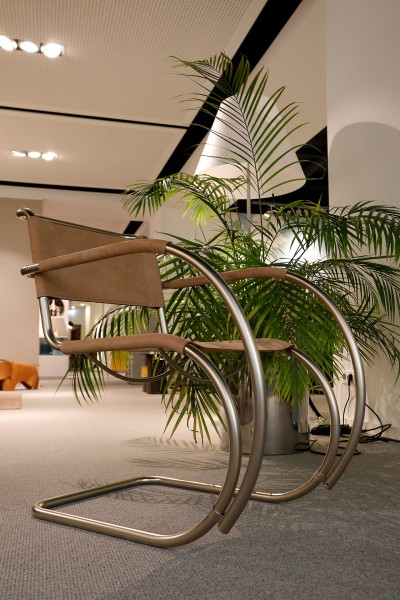The history of the cantilever chair
From the crouch chair to the cantilever chair
Standing on your hind legs: The cantilever chair is a variation of the cantilever chair, a chair that usually has no back legs and only two legs. Chairs are called cantilever chairs when their construction allows them to be sprung by their own body weight, that is, to swing. On the one hand, the two-legged chair was created through experimentation; on the other hand, there were also considerations in the 1920s to produce furniture in a resource-saving way. The name cantilever chair is derived from the verb kragen and means to protrude; the English term cantilever chair is more accurate, cantilever chair. The cantilever chair also marks a rethinking of the ergonomics of sitting, from a rigid seated posture to dynamic sitting.
From tubular steel to plastic
The history of the cantilever chair began with bent tubular steel and led via Verner Panton and the Panton Chair to Konstantin Grcic's Citizen, which is not a biped and not a classic cantilever, but swings thanks to a clever suspension system. The Wilkhahn Stitz and the Wilhahn Stand up also embody the ideas of swinging seating; both models manage with just one leg. It will be interesting to see how the cantilever chair will continue to evolve with new technologies and world views. One of the fathers of the cantilever chair, Marcel Breuer, had a vision of sitting on air columns; it would be nice, after all, we spend an average of 14 hours sitting. Since there is a counter-trend to every trend, cantilever chairs made of plastic or tubular steel could take turns on the market in the future. In 2020, designer Jasper Morrison developed the elegant EVO-C cantilever chair, which is made of 100% through-dyed polypropylene and is therefore fully recyclable. At present, thoughts of sustainability are also playing a major role in the furniture industry, and research is being carried out at full speed into plastics for the furniture industry that can be made from biowaste.
The three fathers of the cantilever chair
In 1926, architect Mart Stam designed the first biped based on a rigid tubular structure. The MR 20, which Bauhaus director Ludwig Mies van der Rohe presented to the public in 1927 at the Weissenhofsiedlung exhibition, was already somewhat more elastic. Marcel Breuer, a young master and head of the carpentry workshop at the Bauhaus, further improved the elasticity and developed numerous variations with tubular steel, including the famous Wassily Chair, which in its early days was called the B3 club chair and is still manufactured today by Knoll International in the finest leather. Some swing chairs are still produced today by the traditional company Thonet, such as the stackable cantilever chair S 43, whose frame is combined with wood (artistic copyright of 1931, Mart Stam). Even better known is the Thonet cantilever chair S 32 by Marcel Breuer from 1928 to 1931, whose wooden parts in beech with tubular mesh are still produced to the present day. Breuer also developed the Thonet S 64 VDR chair in a similar design, although this is not a swing chair but an office swivel chair. With the Thonet S 35 L armchair and stool, Breuer designed a comfortable free-swinging club chair with visually continuous lines. At the same time, matching side tables were also designed, such as the practical Thonet side table set B 9, which fits together to save space.
The authorship of design and construction
Success sometimes brings adversity - especially when money is involved - and so after 1929, artists and manufacturers waged various lawsuits against each other. The question of authorship of the cantilever chair was probably never satisfactorily resolved, but legal peace was established. Mart Stam was awarded the artistic copyright to the chair by the German Imperial Court in 1932, while Ludwig Mies van der Rohe was awarded the rights to some of the technical aspects of the Freischwingers in 1926, including the free swing. Art historians assume that Marcel Breuer also played a not inconsiderable role in the chair's development - quod erat demonstrandum. Later, other well-known designers created their own version of the cantilever chair. In addition, there were and are numerous imitators who use less high-quality material, such as thinner tubes, artificial leather or cheap leather.
Construction and colors
The classic cantilever chair consists of a single metal tube in a sled or S-shape. The frame serves as a support for the seat, the backrest and, if necessary, for the support of the armrests. Seats or cushions and the backrests are hung or clamped into the frames. The Vitra Panton Chair is a cantilever chair made in one piece, a single recyclable plastic surface from head to toe with cult status due to its expressive form and expressive colors. The Chair is now available in six modern colors. The classic cantilever chair is black or natural beech, but the S 43 is now also available in white and gray and numerous bright colors. The Thonet S 64 PV Pure Materials armchair is also available in thirteen fine leather colors.
The cantilever chair - from war to modernity
During World War II, steel was rationed as a material vital to the war effort, so production of cantilever chairs did not pick up speed until after 1945. At the end of the 1950s, there was a move away from New Objectivity with its geometric austerity. The optimism of the post-war period gave rise to Pop Art with its cheerful colors and new types of synthetic materials. Whereas until 1945 only seat shells could be made from plastics, from 1967 it was possible to realize Verner Panton's vision and produce the Panton Chair entirely from plastic. The cantilever chairs are still produced today by Vitra and Thonet as retro furniture. They are used in kitchens, dining rooms and offices. The Pantone Chairs are ideal as dining room chairs, as they are particularly easy to clean. Due to their high quality, all cantilever chairs from Vitra and Thonet are particularly durable. Their cult status gives the items their material value and adds status to any room.




